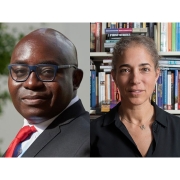Penn Arts & Sciences Magazine: A Neuro Pathway

By Eric Butterman
With Blake Cole
Photo by Michael Branscom
Martha Farah can still remember the smell of the Hayden Planetarium in New York City’s Central Park: “I used to save up my allowance so I could take science classes there. I practically lived in the place.” For Farah, whose parents were both in the arts, wanting to become a scientist was a form of rebellion. As a graduate student in experimental psychology in the 1970s, Farah broke with the pack yet again and joined a group of scientists bent on understanding whether human behavior and psychology were influenced by the brain’s neurological properties—a connection met with widespread skepticism at the time. Now a leading expert in the field of cognitive neuroscience, Farah is conducting research at the interface of neuroscience and society—and nowhere are the stakes higher than poverty’s impact on childhood brain development.
“It goes back to when my daughter was an infant and I hired babysitters. Some of these women had grown up on welfare and were receiving welfare themselves,” says Farah, Walter H. Annenberg Professor in the Natural Sciences. As she got to know them better, Farah was shocked by what she learned of the women’s lives. “Their daughters and sons and nieces and nephews began life with the same evident promise as my daughter and her friends. Yet as the years went on, I saw their paths diverge. On our side of the tracks, preschoolers knew their letters and numbers, elementary school children were familiar with different neighborhoods and different cities, and middle school children read newspaper headlines and asked their parents about them.”
The children raised in poverty did not keep up with these milestones, but they were ahead of their peers in their first-hand experience with violence, death, and the criminal justice system. “The preschoolers knew to fear the neighbors from the local crack house, by elementary school they recognized the sound of gun shots, and by middle school they knew about prison because a relative had been there,” says Farah, who has been named a fellow of both the American Association for the Advancement of Science and the American Academy of Arts and Sciences. “While middle class children get abundant opportunities to explore with relative safety, poor children live under great stress and fall more behind each year.”
Her findings are based upon field research that began in 2000, and is still ongoing. Farah, along with graduate student Kim Noble, C’98, GR’05, M’07, and pediatrics professor Hallam Hurt of the Children’s Hospital of Philadelphia, started working with Philadelphia families in order to collect information on childhood socioeconomic status (SES) and investigate its correlation with lifelong mental health, cognitive ability, and academic achievement. She used computerized testing to measure aspects of the children’s performance during tasks that were known from previous research to engage specific neurocognitive processes. She found that poor children were less likely to develop strong learning and memory abilities, and this was attributable in part to their stressful lives.
“The samples we examined suggested these stress levels were negatively impacting language, memory, and the ability to flexibly focus attention on the task at hand,” Farah says. She was particularly interested in the link between stress and memory: “You might not expect the two to be closely related, but there is ample neuroscience research showing a link, and we found that the kids with the weakest memories had parents who were less able to protect them from the stress of poverty.”
Noble, who is now a professor at Columbia University, recently led a comprehensive project to examine whether children’s brains were being affected on an anatomical level. “It has greatly clarified the picture of these effects,” Farah says. “They are independent of race and ethnicity, and the differences are biggest between the very poor and poor, rather than differences within middle class between, say, lower- and upper-middle class.”
Where do the results lead? “A little bit of stress is inevitable and probably healthy, but unrelenting severe stress, which is surprisingly common in poor families, is neurotoxic,” says Farah. “It’s just one more argument for providing the necessary aid for parents to ensure these kids are not overly stressed in their formative years.”
It wasn’t long ago that such connections would have been discredited. The inception of cognitive neuroscience as a serious research field was a complicated one, she recalls. “In the 1970s, relating neuroscience to the mind was considered radical,” says Farah, who was a graduate student in experimental psychology at Harvard at the time. "When I asked my advisor to sign a cross-registration form for a neuroscience course, he lectured me on the mistaken notion that the brain’s hardware could tell us anything about its software.”
Cognitive psychologists were making tremendous progress studying the mind scientifically by using a theoretical framework from computer science. This model made it possible to discuss mental entities scientifically, even though they were not concrete physical objects, by viewing them as information structures. “Unfortunately, this conceptual advance in psychology got people thinking about information as it was represented in their office computers—where hardware and software had been engineered to be quite separate,” says Farah. “So they assumed that information in the brain’s ‘software’ was independent of the physical details of the brain.”
By the 1980s this perspective began to change. For her dissertation, Farah was confronting a question that was proving difficult to solve using traditional methods of psychology: “There was a controversy over mental imagery, or ‘seeing with the mind’s eye.’ Was it based on perceptual representations, or a more abstract form of thought?” Her research found that patients with damage to the visual areas of the brain showed changes in their mental imagery that paralleled changes in their perception. This made sense only if they were using their damaged visual perceptual representations for imagination. With the advent of functional brain imaging, she confirmed this: “The parts of the brain that became active when people imagined with their mind’s eye included parts of the visual system,” says Farah. “It was very exciting to be able to open the black box of the mind and see how it was organized.”
Now that the science is established, the challenge becomes using the extrapolations from a wide-arching, dynamic study like the one of poverty and its effects on the brain, and implementing real-life solutions. Toward this end, Farah’s team is combining forces with the Abecedarian Project, which between 1972 and 1977 carried out one of the most successful interventions ever documented to promote early childhood education and development of infants from low-income families. Farah, along with Craig Ramey, a professor of psychology and pediatrics; Sharon Ramey, a professor of psychology and psychiatry; and Read Montague, a professor of physics and of psychiatry and behavioral medicine (all from Virginia Tech), will be inviting “graduates” of the infancy-through-elementary school program and the control subjects to Virginia Tech for fMRI scanning, in order to see how a good education-based intervention impacts brain development.
Farah has balanced her research with her duties as founder of two centers at Penn: the Center for Cognitive Neuroscience (CCN), which she directed from 1999-2010, and the Center for Neuroscience and Society (CNS). The CCN is a multidisciplinary community dedicated to understanding the neural bases of human thought. As director, Farah used various forms of social engineering, including mixing students and staff from different faculty labs and housing them in offices with communal resources. “You’d be bumping into other faculty and students when you were heating your lunch or analyzing your brain images,” says Farah. “We ended up with a wonderful group of people, with many close collaborations among them.” The CCN continues to flourish under the co-direction of Christopher H. Browne Distinguished Professor of Psychology Sharon Thompson-Schill and Professor of Neurology and Radiology John Detre in the Perelman School of Medicine.
The CNS, which Farah founded in 2009, works to address the ethical, legal, and social implications of neuroscience. It brings together faculty and students from Penn Arts and Sciences, the Perelman School of Medicine, Engineering and Applied Science, and Law, as well as Wharton. “With neuroscience touching our lives in so many ways, from ad campaigns formulated with neuromarketing methods to judicial decisions citing brain imaging evidence, we need to analyze the impact of neuroscience on society and work to encourage responsible, positive uses,” says Farah. CNS also hosts the Neuroscience Boot Camp, which brings non-scientific professionals like reporters and lawyers to Penn to learn more about the latest in neuroscience and what it means to society. Farah and colleagues have also worked with the Franklin Institute and the School District of Philadelphia to introduce neuroscience courses into several city high schools.
In addition, CNS now offers a new certificate program in Social, Cognitive and Affective Neuroscience (SCAN) that helps prepare graduate students to work knowledgeably with neuroscience in a wide range of careers. The curriculum focuses on the aspects of neuroscience that have the most direct application to the understanding of human behavior, and so far students have come from a variety of humanities and social sciences departments as well as the law school and the Graduate School of Education. “We want to equip these students to think critically about the role of neuroscience in the new ‘neuro-fields’ like neurolaw, neuroeconomics, neuroethics, and so forth,” says Farah. “It is so rewarding to teach these students, who are smart, mature learners but just beginning to discover neuroscience.”
This summer, Farah plans to catch up on her writing, including an article on transcranial direct current simulation (tDCS), a new method for influencing brain function by running very low current through the brain. “A lot of people have started using it—some even at their own home with batteries and wire from a hardware store,” she says. “Not recommended, by the way!” Her article is a quantitative review of the cognitive enhancing effects of tDCS. “There is a lot of controversy over whether it can improve cognition in a normal, healthy person. We are hoping to clear things up a bit.”





